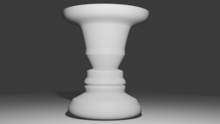This article needs additional citations for verification. (November 2015) |

Rubin's vase (sometimes known as the Rubin face or the figure–ground vase) is a famous example of ambiguous or bi-stable (i.e., reversing) two-dimensional forms developed around 1915 by the Danish psychologist Edgar Rubin.[1]
The depicted version of Rubin's vase can be seen as the black profiles of two people looking towards each other or as a white vase, but not both.
Another example of a bistable figure Rubin included in his Danish-language, two-volume book was the Maltese cross.

Rubin presented in his doctoral thesis (1915) a detailed description of the visual figure-ground relationship, an outgrowth of the visual perception and memory work in the laboratory of his mentor, Georg Elias Müller.[2] One element of Rubin's research may be summarized in the fundamental principle, "When two fields have a common border, and one is seen as figure and the other as ground, the immediate perceptual experience is characterized by a shaping effect which emerges from the common border of the fields and which operates only on one field or operates more strongly on one than on the other".
- ^ Rubin, E. (1915). Synsoplevede figurer: Studier i psykologisk analyse [Perceived figures: Studies in psychological analysis]. Gyldendal, Nordisk forlag.
- ^ "Looking back: Figure and ground at 100 | The Psychologist".